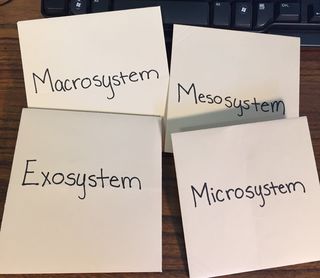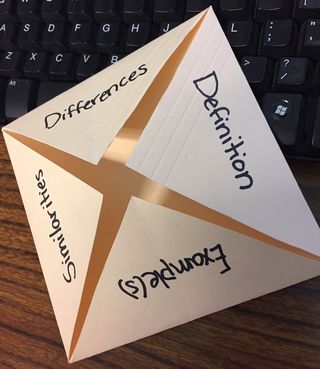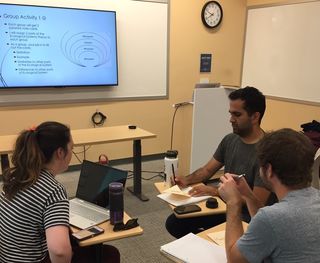Education
My Students Just Improved My Teaching—and Learning
What can be better than my five-sided flash card?
Posted June 10, 2019
I’m writing about a new wrinkle on a traditional learning method: flash cards. This innovation was developed by the students in my graduate course on teaching:

- Princi Kovacs
- Alex Presciutti
- Stephanie Callan
- Dustin Goerlitz
- Emily Bilenduke
- Bahroze Rakeen
About five years ago I introduced, in this very blog, the “Five-Sided Flash Card.” Instead of just the terms and definitions on traditional cards, my flash card had these five sides:
- Side 1: Term or Concept.
- Side 2: Definition.
- Side 3: Example, Picture, or Story.
- Side 4: Similarities to Other Terms or Concepts.
- Side 5: Differences from Other Terms or Concepts.
Some readers thought this was a pretty good idea—a couple wrote to me to ask (a) how to make the cards, and/or (b) where they could buy a set! Alas, I had to tell them that actual cards didn’t exist. I have students discuss the elements of the “cards,” either in class or as a study technique. That approach worked best.
Until now.
In our teaching course this year, students read my previous blog post and really liked the idea of helping students generate examples of concepts and relating them to other concepts. I’ve seen that reaction before. What I saw for the first time, however, was their desire to turn this metaphor into a reality. They spent time in class playing with the idea, folding paper, laughing (respectfully) at their colleague's attempts, and ignoring my encouragement to "get back on the right track."
I thought the matter was over until the last day of the course when Princi surprised us all. As part of her ETO (“Experiential Teaching Opportunity”), she gave a short presentation on Bronfenbrenner’s ecological model of development. After the presentation and a couple of multiple-choice review questions, she casually brought out actual flash cards! They’re not exactly five-sided, but they capture the spirit of a true five-sided card! She called them “Pyramid Flash Cards." Here is a picture of one side of the cards, with the concepts to be reviewed:

And here is the reverse of one of the cards, with the other four necessary components as sides of the pyramid:

The beauty of this design is that students can open the flaps and write in definitions, examples, and relationships to other concepts:


We had a lot to celebrate this past week: (a) the course ended, (b) we learned about some of Bronfrenbrenner’s major concepts, (c) we shared in developing an innovative study and learning technique, and (d) I learned that I don't always know what the right track is! Once again, letting students play really paid off.



